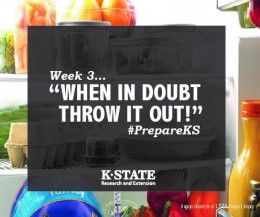September is National Preparedness Month. It is also our annual Prepare Kansas online challenge. Prepare Kansas 2016 will provide tips on keeping food safe in emergency situations. This year’s program will be conducted through the K-State Research and Extension Facebook page. No registration is required, so Kansans and anyone interested in planning ahead for emergencies can follow on Facebook and this blog at any time during September, pick up handy information and interact with K-State extension specialists and agents. Today’s post is written by Londa Nwadike, State Extension Consumer Food Safety Specialist for Kansas and Missouri.
After a flood has devastated your home or business, there are many things to be considered, one of which is food safety. Flood water should generally be considered as contaminated, as it is difficult to determine what it has contacted on its way to your property. Water from floods can be contaminated with sewage or animal waste, as well as heavy metals or other chemical industrial contaminants, all of which can be hazardous to human health if consumed.
If you are not sure if the food was directly exposed to flood waters or not, it is safer to throw out the food: “If in doubt, throw it out”. This KSU publication contains a more complete list, but in general, if any of the following food items are exposed (or even if potentially splashed with) flood waters, they must be thrown out, even if they would be cooked before consuming, as heavy metals and chemical contaminants are not removed by cooking:
- Food items in your refrigerator and freezer
- All foods in boxes, paper, foil or cloth, including cereal, juice, and powdered milk
- Spices and seasonings
- All home canned foods, since the area under the seal of the jars cannot be properly disinfected
- Any food and drinks in containers with screw-caps, pull tops and crimped caps, including salad dressings
- Flour, grain, sugar, coffee and other staples in canisters
All undamaged commercially prepared foods in metal cans and “retort pouches” (such as shelf stable juices) can be kept, but must be thoroughly washed and disinfected. This KSU publication has detailed instructions on how to clean such cans and pouches for safety.
As with many situations, it is very important to wash your hands with clean water (not flood water) after your hands come into contact with flood water. More information on handwashing is available in this blog post.
Kitchen utensils and pans exposed to flood waters must also be evaluated for safety. All metal pans, ceramic dishes, and metal utensils (such as can openers) can be kept, but must be thoroughly washed and sanitized according to instructions available in this KSU publication. Wooden and plastic utensils, baby nipples, pacifiers and any other porous items used with food must be thrown out since any contaminants present cannot be completely cleaned off.





